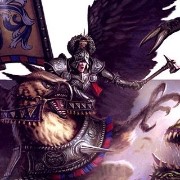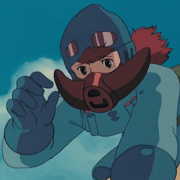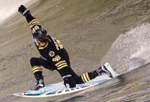|
Koramei posted:I wish I saw more people arguing this, battleships are cool I think it would be fair to argue that battleships/cruisers were important in the european theater, but it was very much less so on the pacific theater. It is interesting to note that in europe battleships sunk the most other battleships (5 to 4 sunk by air), and also sank the most battleships while underway (3). The only sinking of a battleship underway by air was the Roma as it was moving to surrender to the allies, (you could argue the Bismarck as well but it couldn't really have been sunk without the use of battleships, aircraft and cruisers). The prospect of German battleships roaming the Atlantic and attacking convoys was a genuine and very real threat in the early war and also in mid war with the allied convoys to Russia, the same with the Italian battlefleet contesting control of the Mediterranean, especially with the italian fleet it was very neccesary to sink or otherwise prevent their battlefleet from interfering in the Med so that britain could supply North Africa, Malta and not have to send convoys to and from india round the bottom of Africa.
|
|
|
|

|
| # ? May 27, 2024 11:13 |
|
MikeCrotch posted:Planechat: A big deal in the Zero vs F-4 saga was that while a Zero could outperform an F-4 in most ways, it afforded much less protection for the pilot due to lacking things like self-sealing fuel tanks and an armoured cockpit. This meant that once tactics allowed the F-4s to get a shot on the Zeros they were much more likely to shoot them down than the reverse, since F-4s were famous for being able to take a beating while Zeros had about as much durability as wet tissue paper (due to all the design compromises to keep weight down and improve performance). The Phantom could kick the poo poo out of the Zero without even trying. The F4F Wildcat, that's mostly true, and is definitely true once the Zero's out of its limited cannon ammo. Btw, USN aircraft designations, it's the F4F, not the F-4 F. It's the difference between the fourth (4) fighter (first f) made by Grumman (second f) and the sixth variant model of the F-4. If there's no number, such as the SBD, the last letter is the D, the first ones are the role (scout bomber) and the implicit one is left out.
|
|
|
|
Best Chinese leader of men gotta be Ching Shih. Went from hoochie to pirate queen in six years and could not be defeated by either Brits, Portugese or the Qing dynasty navy, though she eventually accepted a crooked amnesty that made her husband leader of the navy, keep all her loot and die fat and happy running a casino 
|
|
|
|
Polyakov posted:I think it would be fair to argue that battleships/cruisers were important in the european theater, but it was very much less so on the pacific theater. Battleships were incredibly valuable in the Pacific, too, just not for their intended purpose. In an island-hopping campaign, battleships make for truly wonderful shore bombardment platforms and excellent additions to any amphibious assault task force.
|
|
|
|
Polyakov posted:I think it would be fair to argue that battleships/cruisers were important in the european theater, but it was very much less so on the pacific theater. Was there any interest in/effort to use aircraft carriers in Europe by any side in WWII? Or did the availability of land-based airbases make it not worth the effort for anybody (according to video games, carriers do seem to require a lot of effort)?
|
|
|
|
They were use just mostly in ASW and convoy escort rolls. Lost of escort carriers. Plus they saw use at torch.
|
|
|
|
Ainsley McTree posted:Was there any interest in/effort to use aircraft carriers in Europe by any side in WWII? Or did the availability of land-based airbases make it not worth the effort for anybody (according to video games, carriers do seem to require a lot of effort)? Well, the Germans, Soviets and Italians didn't have any to use, so you're essentially asking about Britain. Escort carriers were used extensively in the Atlantic later in the war, and the attack on Taranto which crippled the Italian fleet was launched from HMS Illustrious. When it came to attacking Germany, though, well, it's right over -> there. Not much need to sail a vulnerable ship up to it when you've got a whole island already in the right position. feedmegin fucked around with this message at 15:05 on May 3, 2016 |
|
|
|
Ainsley McTree posted:Was there any interest in/effort to use aircraft carriers in Europe by any side in WWII? Or did the availability of land-based airbases make it not worth the effort for anybody (according to video games, carriers do seem to require a lot of effort)? They saw a bit of use especially in the Med. The nice thing about carriers is they take a few strikes worth of stores so you don't have to ferry the supplies to an airbase and you can get a bunch of temporary air cover to cover an operation.
|
|
|
|
Cythereal posted:Battleships were incredibly valuable in the Pacific, too, just not for their intended purpose. In an island-hopping campaign, battleships make for truly wonderful shore bombardment platforms and excellent additions to any amphibious assault task force. Battleships and cruisers were also useful/necessary for night-time operations, when the carrier or land-based aircraft attacks could not be effectively used. See all of the night-time surface combat during the Guadalcanal campaign (and read Neptune's Inferno, its a fantastic book).
|
|
|
|
xthetenth posted:They saw a bit of use especially in the Med. The nice thing about carriers is they take a few strikes worth of stores so you don't have to ferry the supplies to an airbase and you can get a bunch of temporary air cover to cover an operation. That being said, the European theater didn't see carriers used the same way they were in the Pacific, no. The massive carrier task forces employed by the Americans and Japanese were an innovation uniquely suited to the nature of the Pacific theater, and not applicable to Europe. It's kind of fascinating how incredibly different the two major theaters of WW2 were, and how many weapons, vehicles, technologies, and tactics were useless on one theater but valuable in the other. Gully Foyle posted:Battleships and cruisers were also useful/necessary for night-time operations, when the carrier or land-based aircraft attacks could not be effectively used. See all of the night-time surface combat during the Guadalcanal campaign (and read Neptune's Inferno, its a fantastic book). Quite true. (And I have Neptune's Inferno. That, Shattered Sword, and Last Stand of the Tin Can Sailors were under my Christmas tree this past year) Cythereal fucked around with this message at 15:21 on May 3, 2016 |
|
|
|
Cythereal posted:That being said, the European theater didn't see carriers used the same way they were in the Pacific, no. The massive carrier task forces employed by the Americans and Japanese were an innovation uniquely suited to the nature of the Pacific theater, and not applicable to Europe. For a year and change in the Pacific war there were no large carrier task forces. Think about the period between Midway through late 1943. Battleships roamed the Solomons relatively safely and were quite important beyond naval bombardment.
|
|
|
|
Ainsley McTree posted:Was there any interest in/effort to use aircraft carriers in Europe by any side in WWII? Or did the availability of land-based airbases make it not worth the effort for anybody (according to video games, carriers do seem to require a lot of effort)? There wasnt really a need to use aircraft carriers so much as it was better to use land based bombers in any case where they were in range, the British were pretty much the only people that operated them and as other people have said they were used mainly for convoy protection, though they did have a very important use in keeping Malta operating as an airbase, (it being much better to fly planes to an unsinkable island to harass german supplies to north africa than risk the carriers being sunk.) They were also briefly used to hunt german surface raiders, the Bismarck and the Graf Spee both being targets, one successfully one not. They were used essentially to go where land based air couldn't go. Merchant Aircraft Carriers and Catapult Aircraft Merchant ships were very widely used in the atlantic to provide submarine protection, Coastal Command didnt really get enough long range bombers to cover the atlantic air gap until mid 1943 and until that point these pseudo aircraft carriers were used as stop-gaps. CAM's were essentially merchant ships with a steam catapult bolted on that launched a single hurricane to chase away Condors and provide some defence against bombers that were shadowing/attacking the convoy, the fighter was then ditched in the sea and the pilot recovered, MAC's were merchant ships that still carried cargo but had a deck put on top to launch a handful of swordfish from to hunt submarines, though by the time they were widely used the battle of the Atlantic had already been won essentially. (Though escort carriers were used extensively to fly ASW aircraft). Actual fleet carriers were employed for the Torch landings and to escort convoys where they were likely to face significant air attack; into the Meditteranean, near Biscay and convoys across to Russia, where they did a pretty good job of keeping the convoys safe from air attack. The Med was a very risky place to be a carrier in WW2 with the RN losing 2 fleet carriers (Ark Royal and Eagle) and an escort carrier to U-Boats, the two fleet carriers being used to ferry aircraft to Malta and the escort carrier on convoy protection, (They would come within range of the island and launch the aircraft on a one way trip to reinforce the island). Two other fleet carriers were lost in the north, the Courageous to a submarine very early on in the war as it was hunting submarines, and the Glorious to the Scharnhorst and the Gneisenau as it tried to return to Scapa Flow after covering the evacuation of Norway, while we dont know for sure given that very few of the crew survived it seemed to be that her captain was impatient to court martial the Air Commander for refusing to attack land targets in Norway and detached from Ark Royal to do so faster.
|
|
|
|
Actually, question about that - how effective were land-based naval bombers in WW2? Did they compare well against their carrier-based counterparts?
|
|
|
|
Anyone interested who's never seen it, this explains how the Wildcats evened things up against the Zeros (through teamwork/tactics), early on: https://www.youtube.com/watch?v=C_iW1T3yg80
|
|
|
|
Tomn posted:Actually, question about that - how effective were land-based naval bombers in WW2? Did they compare well against their carrier-based counterparts? Worst case they were something like land dive bombers with short legs, worst case for carrier havers they were just carrier planes, best case they had longer legs and or capacity, ask the PoW and Repulse about that.
|
|
|
|
Endman posted:Can anyone tell me more about the Loricati of Otto II & III's Western Francia (c. 900-1000 AD)? From a little poking around they seem to just be the explicitly mounted and armored men of a comitatus. Proto-knights, essentially. Also is Tom Holland writing after a particular fashion? His stuff reads super weird.
|
|
|
|
Fangz posted:Would I be correct in suggesting that relative performance differences between WWII fighters is really not as all-important as people seem to think? I like this question. It wasn't as important as say for instance discussion boards about video games would have you believe. Like, the guys who will argue for days over how much boost the DB605 could manage at both standard and emergency throttle, on what octane, and how that affected the climb rate of the 109K, and so, and clearly my favorite aircraft underperforms, and so on. It is similar to those endless discussions about how many mms of penetration does tank have at armor angle and etc. That being said, aircraft performance was probably the most immediately relevant techno-nerd type thing to the actual warfighters, just due to the simple fact that aircraft and particularly fighters were far more likely to meet up and have to fight against their "peers" than were tanks or battleships or whatever other platform we might want to argue about. The real issue, in my opinion at least, is that people tend to focus on the wrong performance parameters. An extra 20km/h in level flight is cool and impressive/important in video games, but less sexy measures, like engine reliability, endurance, ceiling, and so on were just as important if not moreso than climb rate or speed or roll rate. When you couple that with the fact that, for the most part, performance across first order air forces was pretty similar throughout the war, and the fact that performance could vary wildly between different planes of the same type, you get the idea. And of course, all of the performance in the world has to be employed properly, and maintained, and supplied, and so on, most of which we ignore. There really were some serious technical capability upgrades that made a tangible difference in the outcome of the air war, I'd argue much moreso than a heavy tank gun or a battleship fire control radar or whatever ever affected their respective domains. The P-51's range is a good example: there simply wasn't another aircraft that could do what it did for as long as it did, and at the point in time where it was introduced, that capability was badly needed and thus it had a pretty huge effect on the outcome of the air war. The Me-262's speed/armament is another example: though it didn't (and wouldn't have, ever) changed the outcome of the war, it was such a quantum leap in capability that it basically rendered every prop fighter obsolete in a period of a couple of months. Another issue to consider I'll offer in view of the F4F vs A6M discussion: while you all were right that the USN managed to adapt its tactics to suit the F4F's strengths/weaknesses, its poor performance was still a pretty significant hindrance. The Thach weave was essentially a purely defensive tactic, the same as a Lufbery circle or similar. In other words, while it allowed you as a fighter pilot to survive the engagement, it ceded initiative to the better performing fighter, and that meant that you really never could achieve even temporary air superiority. Couple that with the Zero's much better endurance, and that is a pretty big capability shortfall in a theater like the Pacific. Despite having pretty capable pilots and a solid tactical foundation, the F4F really did pretty poorly overall....Midway, for instance, as we all know, was really won by a combination of superior intelligence, operational decisions, and luck....the F4F's generally either got mauled or ran out of gas. bewbies fucked around with this message at 16:55 on May 3, 2016 |
|
|
|
MrMojok posted:Anyone interested who's never seen it, this explains how the Wildcats evened things up against the Zeros (through teamwork/tactics), early on: "Don't think about flying a plane. Think about flying a bullet."
|
|
|
|
Yeah, the type of chat you see on WWII fighter combat game message boards, and even on sites that are simply about aircraft and their performance, gets really old, really fast. On the game boards most people in the twenty-page "ZERO VS WILDCAT" -type threads have agendas, usually "my favorite plane doesn't perform as well as peer plane X so I get shot down too much online." The non-game message boards are full of people with agendas too, stuff like plane-crusaders who are convined the P-47 was the greatest plane of the war and are determined to spend their life arguing this on the internet. Or Wehraboos and their Allied equivalents, "All allied planes were poo poo, German planes were superior in all ways" Then there are the people who talk about wing loading and all other types of aerodynamic factors, to "prove" that plane X had a tighter turning circle than plane Y, while ignoring that to achieve this turn rate, you'd have to be riding it right on the edge of a stall, stick shaking, and maybe a lot of inexperienced pilots would never push it that far under any circumstances, for fear of stall escalating into a spin. I think things like pilot quality, specifically the decrease in Axis pilot quality (due to endless war, fly till you get maimed/crippled/killed), difference in quantity of fuel and quality of fuel by the last couple of years of war, and difference in workmanship/construction materials the last couple of years, are more interesting than the charts and tests that people pull out showing that on 1/6/44 a FW-190D9 in immaculate condition, during a test achieved such and such speed at such and such altitude so therefore it was superior to P-51D-20-NA. Also there is the fact that aerial combat in WWII was pretty much about bushwhacking people, where maybe 80% of the time a guy who got shot down either never saw his attacker, or didn't see him until it was too late. If flight A has the altitude advantage, drops down out of the sun etc., it won't matter that their planes were 12 mph slower at 20,000 feet than their opponents' planes.
|
|
|
|
That being said, upgrading from Wildcats to Hellcats and Corsairs was still probably a significant step up for American naval aviators in the Pacific versus the Zero. 
|
|
|
|
Cythereal posted:That being said, upgrading from Wildcats to Hellcats and Corsairs was still probably a significant step up for American naval aviators in the Pacific versus the Zero. Yes it was 
|
|
|
|
Tomn posted:Actually, question about that - how effective were land-based naval bombers in WW2? Did they compare well against their carrier-based counterparts? Its an interesting question to answer, it kind of depends by area, the British deliberately used the long arctic nights to cover convoys going north from german land based air, as previously mentioned no bomber was effective at night, while there were air attacks on the arctic convoys they were typically small and didnt have a great effect. In the early war the FW Condor was very successful at attacking targets in the Atlantic, it could find isolated merchant ships and sink them effectively, it usually attacked at low altitude to enable accuracy, they tended to operate alone in coordination with the U-Boats, once convoys started being escorted though they were driven to higher altitude so their accuracy suffered, this is where the escort carriers started to come in, as the Condor had to operate in daylight as soon as fighters started appearing over the atlantic they were in trouble, as unescorted bombers were easy for any fighter to shoot down. It was however perhaps less useful in its direct attack role and more useful in passing ship sightings to U-Boats for later ambush. In the Mediterenean things were a lot more hectic, with land based bombers like the Ju87/88 and the Italian SM79's actually being in reasonable range of the Allied convoy routes, they managed to completely cut Malta's lines of supply for extended periods (they never managed to cut Egypts supply lines as the RN just sent the convoys round south africa), they rendered it impossible for allied shipping to really move in the Med. It was also very difficult for Axis shipping to reach north africa with Malta being used as a base for bombers with about two thirds of shipping bound for the Afrika Corps being sunk by the time of El Alamein. I dont know a lot about the campaign in the air beyond a few main battles, the one i can recall immediately was Operation Pedestal which was the convoy that the Axis really needed to stop and once it went through the battle started to shift in the allies favour again, the British assembled about 15 merchant ships, 4 carriers and 2 battleships plus escorts and tried to run the blockade to malta. The Axis threw a significant amount of air and submarines at the convoy and sunk about 10 of the merchant ships, one of the cruisers and one of the aircraft carriers (to a submarine), but because they had a significant amount of air cover they had forced the dive bombers to stay high and the torpedo bombers to launch early which meant that their accuracy was pretty poor and the convoy managed to get through, but even given the heavy escort of the convoy the land bombers did give a pretty good showing of themselves. The Allies knew that sending unescorted ships within range of land based air during the day was a very risky proposition so they tended to avoid doing so unless they really didn't have another choice, and made sure to try and escort it properly. But it does show that land based air was pretty much as effective as naval air at sinking ships, but no bomber could be relied on to hit its target if there were fighters in the area. Broadly though as xthetenth said they were as effective as each other, as long as the crews were trained to hit ships they could do so as well in any kind of plane.
|
|
|
|
Cythereal posted:Battleships were incredibly valuable in the Pacific, too, just not for their intended purpose. In an island-hopping campaign, battleships make for truly wonderful shore bombardment platforms and excellent additions to any amphibious assault task force. Battleships shore bombardment utility is overstated, they're just not accurate enough to hit point targets and really aren't delivering a whole lot of explosive (the "high-capacity" round for the Iowa's 16" guns contained a whopping 150 lbs of HE); an aircraft of the day can deliver more damage more accurately with a 500-lb GP bomb. Without having troops ashore already to direct fires against a heavily dug-in enemy, you're not destroying much of value. So you wind up with two-week bombardment periods that didn't do much. The low explosive payload meant you needed a direct hit. Even coconut log bunkers served to stop fragments, and again, those were damned hard to spot from a distance. The flat trajectory of the shells also meant that if you were sheltered by even a small ridge, you were pretty safe. NGFS was more useful during a battle, when it could act to interdict movement, but that's an application where a lot of smaller shells are better than a few big ones. I'd argue that BBs in the Pacific were way more valuable as floating AA platforms. The Colorados carried 16 40mm guns and 32 20mm guns in 1942, later in the war they were carrying *40* 40mm guns and up to 50 20mms.
|
|
|
|
Zeros were poo poo, gimme a Ki-61, -84, -100, or J2M
|
|
|
|
Rodrigo Diaz posted:This strange and marvelous invention called the stool. If you're a really baller Persian Shah, you stand on a captured Roman Emperor to climb on your horse.
|
|
|
|
Libluini posted:To be fair, I did say I was maybe a bit unfair about this. None, we burn them.
|
|
|
|
Jamwad Hilder posted:Generals I'm confident most American people will have definitely heard of: Alexander the Great, Julius Caesar, Genghis Khan, Napoleon, Washington, Cornwallis, Lee, Grant, Sherman, Patton, Rommel, Eisenhower, Schwarzkopf. I wouldn't give people much credit beyond that. Who is Cornwallis?
|
|
|
|
Phanatic posted:Yeah, if you start talking about big technological gaps like between having gunpowder muskets on one side and sticks with chunks of obsidian stuck in them on the other side. Or cannon and gatling guns vs .assegais, that kind of thing. Hey i want to take issue with this for a couple reasons 1) The Aztecs weren't cavemen, the conquistadors reliably recorded that atlatls were dangerous as poo poo 2) They also recorded that guns weren't useful against Indians, who didn't have forts, plate armor, or for the most part formations. The most important parts of the conquistadors' battlefield kit (like "besides smallpox") were horses and metal armor, which were among their most "primitive" technologies This is important because it undermines the linear march of progress. the most sophisticated stuff in the spanish arsenal was designed for problems that didn't exist in the Americas yet. I read some popular history, Empire of the Summer Moon i think, that argued that Indian longbows got dramatically more effective in native vs. settler fighting in the period between conquest and when guns caught up with them in rate of fire 350ish years later, not because the bows themselves changed but because countermeasures against them gradually disappeared from white people's warfighting kit.
|
|
|
|
LLSix posted:Who is Cornwallis? Lost to Washington at Yorktown
|
|
|
|
swamp waste posted:
I read about something similar happening with the tribes in New England using cavalry lances to good effect. Agean90 fucked around with this message at 22:13 on May 3, 2016 |
|
|
|
To be fair, lances didn't really phase out until the 19th century. Britain used very lance-like swords for its cavalry in WW1, somebody linked the bayonet lance for France a while ago. The New South Whales were used in the Boer War and may have still had lances in WW1, I can't find anything that confirms that though. Lances are just awesome cavalry weapons, mainly because they're a horse pike.
|
|
|
|
Rodrigo Diaz posted:From a little poking around they seem to just be the explicitly mounted and armored men of a comitatus. Proto-knights, essentially. Also is Tom Holland writing after a particular fashion? His stuff reads super weird. That's pretty much what I thought, thanks! As for Tom Holland, I'm not quite sure what you mean by weird, but he's very much a narrative historian who wants to tell a good story with profound, overarching themes over delving into much detail. Millennium, for example, talks a lot about Christian anxiety about the looming second coming of Christ, using it as a central theme and following it rather than staying glued to a particular region or people. I'm a big fan because he converts history into a comfy bedtime story, which is a nice change from most of the dry academic journals and primary sources on how many denars you'd have to pay for tripping over a pregnant lady in 7th century Francia that I'm usually obliged to read.
|
|
|
|
Hazzard posted:The New South Whales were used in the Boer War and may have still had lances in WW1 Australian Whale Cavalry?!
|
|
|
|
Naval warfare is where a technological advantage seemed to really change everything. With infantry, it's hard to get around the fact that the same methods of killing a person generally work out, but when firearms came around, all of a sudden the age old strategy of ramming and boarding isn't an option. You have these big Portuguese ships demolishing little Indian galleys and the Korean turtle ships destroying the Japanese navy with barely a scratch. Ironclads threatened to bring about similar confrontations, but I don't know if they actually happened. I don't know if there were similarly one-sided confrontations with fighting Native Americans until the Europeans already had a major logistical advantage.
|
|
|
|
swamp waste posted:This is important because it undermines the linear march of progress. the most sophisticated stuff in the spanish arsenal was designed for problems that didn't exist in the Americas yet.
|
|
|
|
HEY GAL posted:incorrect: the fortress of Acoma was (and still is) swag as gently caress Someday I'm going to read about a crazy person constructing a star-shaped earthwork around their house outside College Town near University of State and I'm just going to nod knowingly to myself.
|
|
|
|
LLSix posted:Who is Cornwallis? He surrendered to Washington at Yorktown so I think he's pretty well known in the US because of that. Lafayette might be another one most people here have heard of, not as sure about that though.
|
|
|
|
Jamwad Hilder posted:He surrendered to Washington at Yorktown so I think he's pretty well known in the US because of that. There's a bunch of cities name Lafayette, but I bet a lot of people don't know why. I was always partial to Thaddeus Kosciuszko, myself. The guy who taught Washington how to run an army.
|
|
|
|
Jamwad Hilder posted:He surrendered to Washington at Yorktown so I think he's pretty well known in the US because of that. If he wasn't famous before Hamilton, he probably is now
|
|
|
|

|
| # ? May 27, 2024 11:13 |
|
Don't forget the Lafayette Escadrille from WW1 that just celebrated its centenary!
|
|
|







































